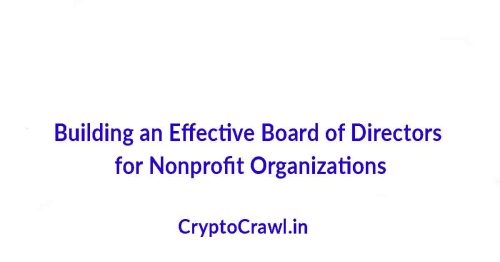Welcome to our journey into the world of nonprofit governance! Today, we embark on a quest to unravel the mysteries and intricacies of building an effective board of directors for nonprofit organizations. As stewards of our communities, the role of a board is paramount in steering the ship of our organization toward its mission. So, let us delve deep into the heart of this noble endeavor.
Building an Effective Board of Directors for Nonprofit Organizations

At the heart of every nonprofit organization lies its board of directors, a group of dedicated individuals entrusted with guiding its mission and ensuring its success. But what exactly does this entail?
A. Definition and functions of a board in a nonprofit context The board serves as the governing body of the organization, responsible for setting its strategic direction, ensuring financial accountability, and safeguarding its mission and values. It acts as the fiduciary steward of the organization, overseeing its operations and ensuring compliance with legal and ethical standards.
B. Legal and fiduciary responsibilities of board members As stewards of public trust, board members are tasked with upholding the highest standards of accountability and transparency. This includes ensuring compliance with legal and regulatory requirements, prudent financial management, and adherence to the organization’s mission and values.
C. Importance of diversity and inclusion on the board A diverse and inclusive board brings a breadth of perspectives, experiences, and insights to the table, enriching the organization’s decision-making processes and enhancing its effectiveness. By embracing diversity in all its forms, including race, gender, ethnicity, age, and background, boards can better reflect the communities they serve and foster a culture of inclusivity and equity.
Identifying Board Member Qualities and Skills
Now that we understand the pivotal role of the board, the next step is to identify the qualities and skills needed to fulfill this role effectively.
A. Key qualities to look for in potential board members When recruiting new board members, it is essential to look beyond just qualifications and expertise. While skills in areas such as finance, law, marketing, and governance are certainly valuable, equally important are qualities such as passion, commitment, integrity, and a deep-seated belief in the organization’s mission and values.
Allow me to share a story from my own experience. Many years ago, we were searching for a new board member for our environmental conservation organization. We found a candidate with impeccable credentials and years of experience in environmental advocacy. However, what truly set her apart was her unwavering passion for our cause and her genuine connection to the communities we served. It was this passion and commitment that ultimately made her an invaluable asset to our board.
B. Assessing skills gaps and needs within the current board Once we have identified the qualities and skills we seek in potential board members, the next step is to assess the composition of our current board and identify any gaps or areas for improvement. This may involve conducting a skills audit or self-assessment to evaluate the collective strengths and weaknesses of the board and identify areas where additional expertise or diversity may be needed.
C. Strategies for recruiting diverse board members In today’s increasingly diverse and interconnected world, building a board that reflects the rich tapestry of our communities is more important than ever. To achieve this, we must adopt proactive strategies for recruiting diverse board members, including reaching out to underrepresented groups, leveraging our networks and connections, and casting a wide net to attract candidates from diverse backgrounds and perspectives.
Let me share another story with you. Several years ago, I had the privilege of serving on the board of a nonprofit organization dedicated to empowering women and girls. Recognizing the importance of diversity in our leadership ranks, we made a concerted effort to recruit board members from a wide range of backgrounds and experiences. This not only enriched our discussions and decision-making processes but also strengthened our connection to the communities we served, ultimately leading to greater impact and success.
Board Recruitment and Onboarding Process

Now that we have a clear understanding of the qualities and skills we seek in potential board members, the next step is to develop a recruitment strategy and onboarding process to attract and integrate new members into the fold.
A. Developing a clear recruitment strategy Recruitment is not merely a matter of filling seats; it is about finding the right individuals who share our passion, vision, and commitment to the organization’s mission. To achieve this, we must develop a clear and targeted recruitment strategy that identifies potential candidates, communicates our expectations and requirements, and outlines the recruitment process.
One effective strategy is to leverage our existing networks and connections to identify potential candidates who may share our passion and commitment to the cause. This could involve reaching out to colleagues, friends, and acquaintances who are actively involved in our field or community and asking for recommendations or referrals. Additionally, we can utilize online platforms and social media channels to broaden our reach and attract candidates from diverse backgrounds and experiences.
When crafting job descriptions for board positions, it is essential to clearly articulate the responsibilities, expectations, and qualifications required, while also highlighting the unique benefits and rewards of serving on the board. This will help attract candidates who are genuinely interested and committed to the organization’s mission and values.
B. Interviewing and vetting potential board candidates Once we have identified potential candidates, the next step is to conduct thorough interviews and vetting processes to assess their suitability and fit for the board. This may involve reviewing resumes, conducting background checks, and interviewing candidates to gauge their interest, commitment, and alignment with the organization’s mission and values.
During the interview process, it is essential to ask probing questions that delve into the candidate’s background, experience, and motivations for serving on the board. This will help us assess their qualifications, skills, and fit for the role, as well as their potential to contribute positively to the board and the organization as a whole.
C. Onboarding process for new board members Once we have identified and selected new board members, the next step is to onboard them effectively and integrate them into the board and the organization. This may involve providing orientation sessions, training, and resources to familiarize new members with the organization’s mission, values, and operations, as well as their roles and responsibilities as board members.
During the onboarding process, it is important to provide new members with the information, support, and guidance they need to hit the ground running and make meaningful contributions to the board and the organization. This may include providing access to relevant documents and resources, assigning mentors or buddies to guide new members, and facilitating introductions and connections with other board members and key stakeholders.
Establishing Effective Board Governance

With our board members in place, the next step is to establish effective governance structures and processes to ensure the smooth functioning and success of the board and the organization as a whole.
A. Setting clear expectations for board members Clear communication and expectations are essential for ensuring that board members understand their roles, responsibilities, and obligations. This may involve establishing clear attendance requirements, participation expectations, and performance standards for board members, as well as outlining the consequences of non-compliance or underperformance.
By setting clear expectations and holding board members accountable for their actions and contributions, we can foster a culture of accountability, professionalism, and excellence within the board and the organization, ultimately leading to greater effectiveness and success.
B. Establishing effective communication channels within the board Effective communication is the lifeblood of any successful
organization, and the board is no exception. Establishing clear communication channels within the board is essential for fostering collaboration, sharing information, and making informed decisions.
One effective strategy is to hold regular board meetings, either in person or virtually, to discuss key issues, review progress, and make decisions. These meetings provide an opportunity for board members to share updates, ask questions, and provide input on important matters affecting the organization.
In addition to formal board meetings, it is also important to establish open lines of communication outside of meetings, such as through email, phone calls, or online collaboration platforms. This allows board members to stay connected, share information, and collaborate on projects and initiatives between meetings.
By establishing effective communication channels within the board, we can ensure that all members are informed, engaged, and aligned with the organization’s mission and goals, leading to greater cohesion and effectiveness in achieving our objectives.
C. Implementing policies for conflict of interest and confidentiality In the course of their duties, board members may encounter situations where conflicts of interest arise, either real or perceived. To ensure transparency and integrity in decision-making, it is important to establish clear policies and procedures for identifying, disclosing, and managing conflicts of interest.
This may involve requiring board members to annually disclose any potential conflicts of interest and abstain from participating in discussions or decisions where they have a personal or financial interest. Additionally, it may involve establishing mechanisms for reviewing and addressing conflicts of interest fairly and transparently, such as through the use of independent committees or advisors.
Similarly, confidentiality is paramount in protecting sensitive information and maintaining trust and integrity within the board. Establishing clear policies and expectations regarding confidentiality, including the handling of sensitive information and the disclosure of confidential matters, helps to ensure that board members uphold the highest standards of confidentiality and professionalism in their roles.
Nurturing Board Engagement and Commitment
With our governance structures in place, the next step is to nurture board engagement and commitment to ensure that all members are actively involved and invested in the success of the organization.
A. Creating opportunities for ongoing education and development Continuous learning and professional development are essential for keeping board members engaged, informed, and effective in their roles. This may involve providing training sessions, workshops, or seminars on topics relevant to nonprofit governance, leadership, and best practices.
By investing in the ongoing education and development of board members, we can empower them with the knowledge, skills, and resources they need to fulfill their duties effectively and make meaningful contributions to the organization.
B. Fostering a culture of collaboration and teamwork among board members Collaboration and teamwork are the cornerstones of effective board governance. By fostering a culture of collaboration, trust, and respect among board members, we can harness the collective wisdom, experience, and talents of the board to tackle challenges, seize opportunities, and drive positive change.
One way to foster collaboration is to create opportunities for board members to work together on committees or task forces focused on specific issues or initiatives. By leveraging the diverse expertise and perspectives of board members, we can generate innovative ideas, solutions, and strategies to advance the organization’s mission and goals.
C. Recognizing and appreciating board member contributions Recognition and appreciation are powerful motivators for board members, inspiring them to continue their efforts and contributions to the organization. By acknowledging and celebrating the achievements and contributions of board members, we can reinforce their sense of value, belonging, and impact within the organization.
This may involve publicly recognizing board members at meetings or events, highlighting their achievements in newsletters or annual reports, or expressing gratitude through personal notes or gestures of appreciation. By showing appreciation for their efforts and contributions, we can foster a culture of engagement, loyalty, and commitment among board members, ultimately leading to greater success and sustainability for the organization.
Evaluating Board Performance
As stewards of the organization, it is essential that we periodically evaluate the performance of the board to ensure that it is fulfilling its responsibilities effectively and driving positive outcomes for the organization.
A. Developing evaluation criteria for assessing board effectiveness Effective board evaluation begins with establishing clear and measurable criteria for assessing the performance and effectiveness of the board. This may involve identifying key performance indicators (KPIs) related to governance, financial management, strategic planning, and stakeholder engagement, against which the board’s performance can be evaluated.
By establishing clear evaluation criteria, we can provide a framework for assessing the board’s strengths and weaknesses, identifying areas for improvement, and setting goals and benchmarks for future performance.
B. Conducting regular self-assessments and board evaluations Self-assessment and board evaluations are valuable tools for gauging the performance and effectiveness of the board, identifying areas for improvement, and driving continuous improvement and development.
This may involve conducting annual or biannual self-assessments, where board members evaluate their performance and contributions, as well as those of their fellow board members and the board as a whole. Additionally, it may involve conducting periodic external evaluations, where an independent third party assesses the board’s performance against established criteria and benchmarks.
By regularly evaluating the performance of the board, we can identify strengths and weaknesses, address areas for improvement, and drive positive change and development within the board and the organization as a whole.
C. Using feedback to make improvements and adjustments Feedback is a powerful tool for driving improvement and growth within the board. By soliciting feedback from board members, stakeholders, and external evaluators, we can gain valuable insights into the strengths and weaknesses of the board, identify areas for improvement, and make adjustments and improvements as needed.
This may involve conducting surveys, interviews, or focus groups to gather feedback from board members and stakeholders on their perceptions of the board’s performance, effectiveness, and impact. Additionally, it may involve reviewing and analyzing performance data and metrics to identify trends and patterns and inform decision-making and improvement efforts.
By using feedback to make improvements and adjustments, we can ensure that the board remains responsive, adaptive, and effective in fulfilling its responsibilities and driving positive outcomes for the organization.
Conclusion
In closing, building an effective board of directors for a nonprofit organization is no small feat. It requires dedication, commitment, and a deep-seated belief in the organization’s mission and values. But by following the strategies and principles outlined in this blog, we can create a board that is not only diverse, engaged, and effective but also capable of driving positive change and making a lasting impact in the communities we serve.
As stewards of our organizations, let us embrace the challenge of building and nurturing effective boards, and let us work together to ensure that our organizations thrive and succeed for years to come.
ALSO-READ: Steps to Registering Your Nonprofit Organization in 2024
